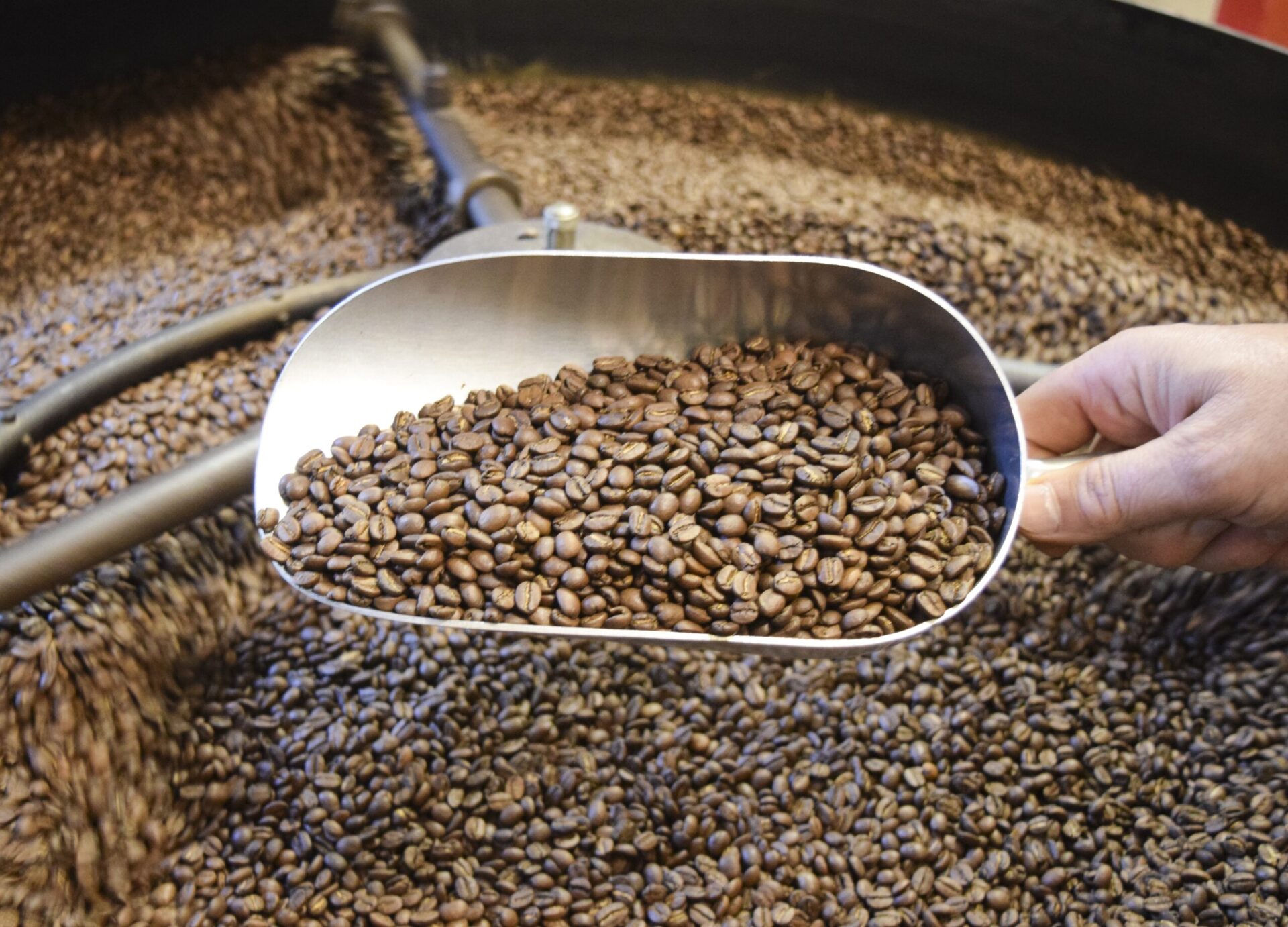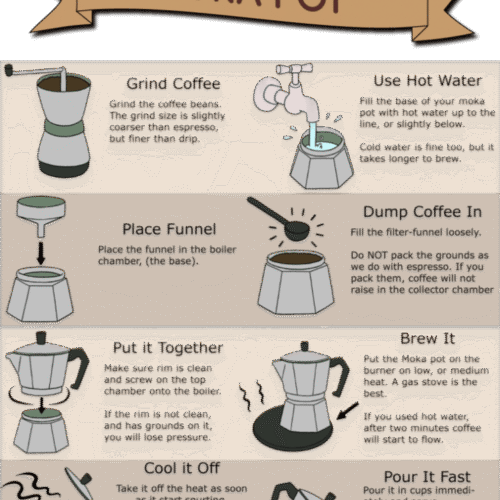To roast coffee beans, preheat your roaster, add the beans, and apply heat for 10-15 minutes. Monitor the color change and listen for crackling sounds for doneness.
Roasting coffee beans at home is a straightforward process that allows for customization of flavor and strength. The freshness of a home roast can drastically enhance your morning cup’s aroma and taste. It involves heating green coffee beans until they turn brown, releasing the flavors we associate with our beloved brew.
The procedure requires consistently high temperatures and attention to detail, as the beans undergo complex chemical reactions affecting their flavor profile. By controlling the roast time and temperature, you can create a range of flavors, from light and acidic to dark and full-bodied. Enthusiasts often roast their beans to guarantee the freshest coffee possible, creating a truly personalized experience.
The Allure Of Home-roasted Coffee
The charm of roasting coffee beans at home is undeniable. Imagine awakening to the invigorating aroma of freshly roasted coffee. Home-roast enthusiasts enjoy full control over their brew’s flavor profile. The process is simple, personal, and utterly satisfying.
The Rise Of Home Roasting
Home roasting has gained momentum amongst coffee aficionados worldwide. This DIY approach allows for experimentation with various beans and roast levels. Personal tastes are prioritized, and the craft of making the perfect cup is celebrated. Home roasters share a common goal: crafting a unique, unforgettable coffee experience.
- Customize roast profiles
- Explore diverse bean origins
- Connect with a global community of enthusiasts
Savoring The Freshness
Nothing competes with the taste of freshly roasted coffee. The freshness factor elevates the coffee experience. Each bean tells its own story through its subtle nuances of taste and aroma. Home roasters savor these details, making each cup more than just a drink—it’s a sensory journey.
- Fulfillment from creating your blend
- Enjoyment of peak flavor after roasting
- Pleasure in sharing your creations with others

Credit: www.amazon.com
Selecting Your Beans
Selecting Your Beans is a crucial step in roasting coffee at home. The types and origins of beans you choose will define the flavor and aroma of your coffee. It’s like picking the main ingredient for your favorite recipe. Let’s dive into how to select the best beans to create your perfect cup.
Types Of Coffee Beans
Understanding the different types of coffee beans is essential. Most beans fall under four main types:
- Arabica: Known for its sweet, soft taste and higher acidity.
- Robusta: Has a stronger, harsher taste with a grain-like overtone.
- Liberica: Unique in flavor with a somewhat woody and smoky profile.
- Excelsa: Offers a tart, fruity flavor profile.
Arabica is most popular among home roasters for its quality and flavor complexity. Yet others prefer the kick from a Robusta or the uniqueness of Liberica and Excelsa. Select a type that tantalizes your taste buds.
Considering Bean Origin And Variety
Once you know the type, consider where it comes from. Coffee beans inherit tastes from their local environment. This gives each origin’s beans a distinct flavor. Different regions offer various taste profiles:
| Region | Flavor Profile |
|---|---|
| Africa | Fruity and floral notes, with a distinctive acidity |
| South America | Sweet and nutty with hints of caramel |
| Asia | Earthy and bold, often with a full body |
Consider your taste preference when selecting a region. Do you enjoy a bright, acidic coffee? Then beans from Africa might be your match. Prefer a sweeter, smoother cup? Look to South America. For a heavy, rich flavor, explore beans from Asia.
The variety of the bean also plays a role. Look for names like Typica, Bourbon, or Geisha. Each variety brings its own flavor twist. Make sure to try different ones to explore the wide range of notes and textures.
Understanding Roasting Equipment
Successful coffee roasting starts with the right equipment. Whether a novice or a seasoned home barista, understanding the different roasting machines and DIY methods is key. Below is a guide to the necessary tools and descriptions of various equipment choices to embark on your home roasting journey.
Roasting Machines Vs. Diy Methods
Roasting machines offer consistency with pre-set profiles and precise temperature control. Many prefer these for their ease of use and reliability. In contrast, DIY methods provide a more hands-on experience. They allow you to experiment with various roasting techniques using simple household items.
| Roasting Machines | DIY Methods |
|---|---|
| Automated roasting | Manual control |
| Consistent results | Custom roast profiles |
| Higher cost | Low investment |
Essential Tools For The Home Roaster
Equipping yourself with the right tools is necessary for quality home roasting. Below are some essentials to consider:
- Roasting appliance: Choose from machines, popcorn poppers, or a simple skillet.
- Green coffee beans: The raw material vital for your roasting process.
- Thermometer: To closely monitor the temperature during the roast.
- Timer: Helps track roast stages for consistency.
- Cooling tray: For quickly cooling beans to stop the roast.
- Storage containers: To keep your roasted beans fresh.
The Roasting Process Decoded
Green coffee beans transform during roasting. Heat coaxes out flavor, aroma, and color. This magical process reveals the bean’s true potential. We’ll dive deep into how this works.
Stages Of Coffee Bean Roasting
Coffee bean roasting involves several key stages. Each stage dramatically changes the beans. Know them well to master roasting.
- Drying Stage: Beans lose moisture. They turn from green to yellow.
- Browning Stage: Beans start developing flavor. This is the Maillard reaction.
- First Crack: A popping sound signals moisture escape. Beans expand.
- Development: After the first crack, the roaster decides how dark to roast.
- Second Crack: If roasting continues, beans crack again. They get darker.
- Cooling: Beans must cool quickly to stop the roasting process.
Controlling Roast Profiles
Roast profiles are recipes for coffee beans. They guide the roasting process to get desired flavors. Each bean needs a unique profile.
| Profile Component | Purpose | Control |
|---|---|---|
| Temperature | Affects speed and quality of roasting. | Use a thermostat to adjust heat. |
| Time | Decides how long to apply heat. | Set a timer to manage roast duration. |
| Air Flow | Removes chaff. Influences flavor development. | Adjust fan speed in the roaster. |
To roast like a pro, practice controlling these profiles. Change one variable at a time, and see how it alters the coffee’s taste.
Cooling And Storing Roasted Beans
After roasting, cooling and storing your coffee beans are critical steps that affect flavor and freshness. Achieving the right cool-down and keeping your beans in optimal conditions will ensure the best taste experience with every cup. Let’s dive into proven methods to preserve the irresistible aroma and taste of freshly roasted beans.
Proper Cooling Techniques
Cooling your beans quickly stops the roasting process and preserves the beans’ desired profile. Spread out your beans on a baking sheet to cool, making sure they’re in a single layer for even air exposure.
- Stir the beans every few minutes to release heat faster.
- Use a dedicated cooling tray with holes to enhance airflow.
- A fan can speed up the process; just avoid blowing debris onto your beans.
Once cool, beans must be stored away to maintain peak freshness.
Best Practices For Storage
Preserve your roasted beans by keeping them in airtight containers away from light, heat, and moisture. Glass or ceramic with airtight seals are the best materials to use.
- Avoid plastic containers as they may impart unwanted flavors.
- Keep beans in a cool, dark place, such as a pantry or cupboard.
- Use within 2 weeks for optimal flavor, and consider freezing if storing longer.
Remember to label the storage container with the roast date. Freshness is paramount, and knowing when you roasted your beans helps you track flavor changes over time.
With these cooling and storing techniques, your coffee routine will elevate to professional levels. Enjoy the ultimate coffee experience right from your home.

Credit: bevmo.com
Brewing The Perfect Cup
Unlocking the secrets of a perfect cup of coffee starts right after roasting the beans. The journey from the roaster to your mug is where magic happens. Let’s dive into how to pair your roasted beans with the ideal brewing method and refine your coffee-making technique.
Matching Roast To Brewing Method
The roast level of your coffee beans greatly affects flavor. Different brewing methods highlight unique characteristics of these roasts. Below, find the best pairings:
| Rost Level | Brewing Method |
|---|---|
| Light Roast | Pour-over, Aeropress |
| Medium Roast | Drip coffee, Siphon |
| Dark Roast | Espresso, French press |
Choose your method and let’s brew a spectacular cup.
Fine-tuning Your Technique
The devil is in the details when it comes to brewing. Follow these steps for a consistently great cup every time:
- Weigh your beans: Consistent coffee-to-water ratios matter.
- Grind fresh: Grind size should match the brewing method.
- Water quality: Use fresh, filtered water for the best flavor.
- Temperature control: Aim for 195°F to 205°F for an optimal brew.
- Brew time: Follow recommended brewing times to avoid over or under-extraction.
Remember, practice makes perfect. Don’t be afraid to tweak methods to suit your taste. Happy brewing!
Common Mistakes To Avoid
Roasting coffee is both an art and a science. Achieving that perfect blend of flavor and aroma is crucial. Yet many beginners make errors that can spoil their beans. Below are common mistakes to avoid to ensure a delicious roast.
Over-roasting
Burning beans is a no-go. Over-roasting often leads to a bitter taste. This bitterness overshadows the beans’ natural flavors. Watch for the color and listen for the second crack. It’s a sign that the roast is reaching its limit.
Under-roasting
Under-roasted beans result in grassy and sour notes. Aim for the perfect color and crack. Light brown is too pale. Beans need to reach a rich brown for a full balance of flavor.
Roast Inconsistencies
Inconsistent roasts can ruin a batch. Uneven heat leads to uneven flavor. Here are steps to ensure uniformity:
- Preheat the roaster to avoid cold spots.
- Stir regularly to expose all beans to heat evenly.
- Timing is key. Note down roasting times for consistency.
Enhancing Your Roasting Skills
Enhancing Your Roasting Skills unlocks new flavors in your coffee cup. Picture yourself savoring a fresh batch of roasted beans, crafted by your own hands. Now, with a little guidance and your growing passion, you’ll refine your techniques. Let’s dive into two essential pillars for honing your craft: learning from fellow enthusiasts and experimenting with various roasting profiles.
Learning From The Coffee Community
Joining the coffee community is a game-changer. It connects you with veteran roasters and newbies alike. It’s a treasure trove of shared experiences that broadens your roasting horizon.
- Attend workshops and seminars to witness roasting first-hand.
- Join online forums, such as Reddit or Home-Barista, to discuss techniques.
- Follow coffee influencers on social media for tips and inspiration.
- Read blogs that focus on the intricacies of roasting.
Knowledge sharing within the community sparks ideas and reveals the nuance in bean preparation. The goal is to absorb expertise from a myriad of sources and translate that into skillful roasting.
Experimenting With Different Roasts
Roasting is an art and science, where practice makes perfect. Experimenting with diverse beans and roast levels allows you to discover the perfect flavor profile.
| Roast Type | Bean Color | Flavor Notes |
|---|---|---|
| Light Roast | Light brown | Fruity and floral |
| Medium Roast | Medium brown | Chocolate and caramel |
| Dark Roast | Dark brown | Bitter and smoky |
Keep notes during each roasting session. Record the beans used, temperatures, and times. Take note of the changes in flavor and aroma with each variation.
- Start with single-origin beans to understand their unique characteristics.
- Alter roast times to see how flavors develop or fade.
- Adjust temperature curves to control the roast intensity.
- Taste each roast, identifying the subtle differences.
Through these experiments, you’ll fine-tune your senses and roasting abilities, leading to that perfect cup of coffee every roaster strives for.

Credit: www.ebay.com
Frequently Asked Questions On How To Roast Coffee Beans
How To Roast Coffee Bean At Home?
Choose green coffee beans and preheat your oven to 450°F (232°C). Spread beans evenly on a baking sheet. Roast for 10-15 minutes, stirring occasionally, until desired color is reached. Cool beans before grinding.
How Long Does It Take To Roast Coffee Beans?
Roasting coffee beans typically takes about 10 to 20 minutes. The exact time depends on the desired roast level and the roasting method used.
How To Roast Coffee Beans Professionally?
To roast coffee beans like a pro, select quality beans and a reliable roaster. Set the temperature between 450°F to 480°F and constantly monitor the color change. Aim for 10 to 15 minutes roasting time, and cool beans immediately after desired roast level is achieved.
What Are The Methods Of Roasting, Coffee?
Coffee roasting methods include air roasting, drum roasting, and hot-air fluid bed roasting. Each technique applies heat differently to transform green coffee beans into aromatic, roasted blends.
Conclusion
Roasting your own coffee beans can elevate your morning cup to new heights. With the basics now in your barista toolkit, you’re set to experiment. Find your favorite roast profile, share it with friends, or keep it as your secret indulgence.
Happy roasting and even happier sipping!








